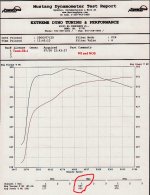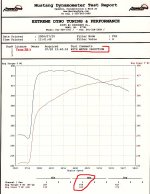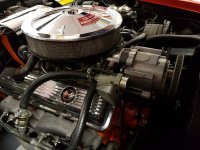Many factors are involved with dyno numbers
Due to that, nameplates could play games to get the marking numbers they want
1, Because of the SAE came up with a standard that nameplates have to adhere to and also someone from SAE
must be present at time the nameplate dyno tests are done
These numbers come as used is an
engine dyno, so reason like GM reports flywheel and not rear wheel numbers
since the later C6s GM has done and reported the SAE engine dyno results
Now must deduct the loss over the drivetrain to the rear wheels
Common loss is deducted, about 10% for a manual tranny and 15% for an auto tranny
Types of chassis dynos
2
Non load bearing
Results from these are about useless, but vehicle owners love them as results are bloated high numbers
One reason is to get the most customers wanting dyno numbers the drum is around 2,700 pounds, so lighter ricer mobiles could be customer base
This leaves the bogus part of results as let's say a C3 and say with driver in car weight is 3,700 pounds that is about 25 % difference of weight mass between drum and car.
Thus, the end numbers would report higher but in fact the car has to only overcome the drum's 2,700 pounds of mass
Meaning if the drum and car were the same weight it would take more HP/Tq to turn that mass.
This type of chassis dyno simply measures, time, that is the time when driver takes the engine close to redline (tranny in 4th gear as 1:1)
and jumps off the gas pedal and the machine than times it took to get the mass to come to a stop
These funny numbers do not factor in weather or elevation, so non-corrected HP/Tq
3. Load bearing chassis dyno
The results would be closer to fact but also leaves for lots of games on cheating the system
The drum is controlled by either water or electrical in adding the load mass of drum to equal the weight of vehicle/driver
and has a weather station to factor in the weather and elevation
Hooked up to this dyno is a P/C with software and this type of dyno (which cannot be done with non-loading type) is the vehicle can be driven like on a road or track thus allowing truer number in the real world
Cannot be done on non load bearing as the simple math explained about, simple is go to 4th gear take to redline and jump off pedal
With load bearing, the shop can make any numbers they want to lie about, such as override what the weight is and what the correct D/A is
An Example I caught as a shop when wanting to market mods was they put the weather station on top of the hot engine during the pulls
Thus, the weather factors are reported much higher and is computed for a higher corrected D/A results
Here are 2 examples using my 1999 C5 on a load bearing chassis dyno and making sure the weight, corrected D/A were correct and
making sure the dyno was calibrated each time
One test is N/A LS1, that I did engine mods to and other run was with 200 HP shot of NOS
These numbers are at the rear wheels.







